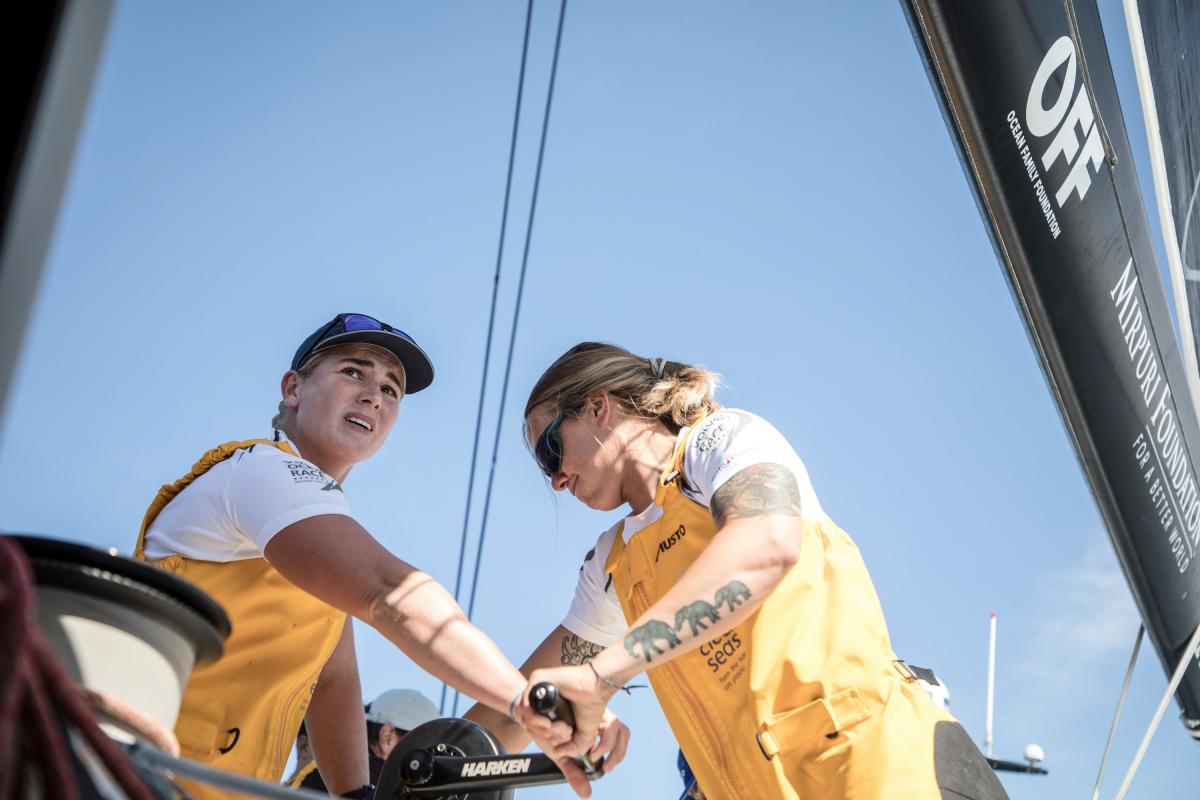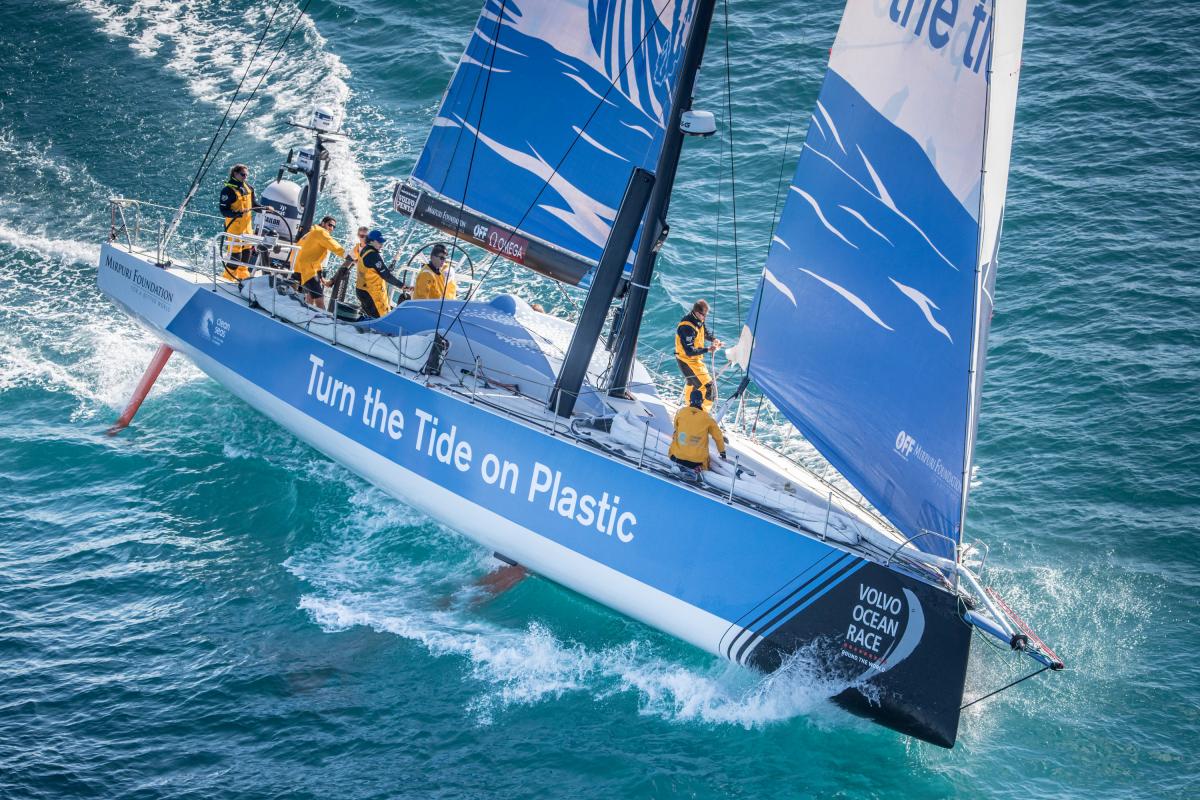The Volvo Ocean Race is awash with facts and figures – like, at 45,000 nautical miles, this edition will be the longest in the history of the race; there is no cash prize for winning (the trophy is regarded as enough incentive); and 13 Olympians competed in the last race in 2014/15.

Bianca Cook (left) is the first Kiwi to compete in the Volvo Ocean Race in a mixed crew. Photo: Volvo Ocean Race.
There are also a couple of pretty significant ones regarding Bianca Cook.
The 28-year-old will become the first Kiwi woman to feature in the race since Keryn McMaster, Bridget Suckling and Sharon Ferris in 2001/02. Not only that, she will also be the first New Zealand woman ever on a mixed boat when she lines up with Turn the Tide on Plastic as the boats leave Alicante on October 22.
All four Kiwis who have been involved in previous races have been on all-women’s crews.
“I didn’t realise that it had been so long since a Kiwi woman had been involved in the Volvo Ocean Race,” Cook says. “To be told that is incredible. I can’t believe that I am able to represent Kiwis let alone female Kiwis. I have sailed with some fantastic women over the years and I’m pretty proud to be representing all of them.”
It very nearly didn’t happen. She had been invited to trial with Turn the Tide on Plastic but couldn’t get to England in time to join the team before the start of the Fastnet Race and assumed her chance of ever doing a Volvo was gone.
“Then I got a call asking me if I would be interested in coming and joining the team and sailing around the world with them. It all happened really, really fast.
“I wasn’t 100 percent sure it was really happening when I came here. It didn’t really sink in until they said they were going to be announcing me. I still can’t believe I’m about to go around the world in a Volvo Ocean Race.”
Cook has effectively been around the world twice already, with more than 70,000 miles on the clock, and it was this experience which helped her earn her ticket to the famous race.
She has done numerous Atlantic crossings, three crossings of the equator, traversed the Northwest Passage linking the Atlantic and Pacific Oceans through the Arctic Ocean and done plenty of sailing around the South Pacific and Asia.
She had originally assumed her elite sailing career would have been in women’s match racing, and she was part of Yachting New Zealand’s extended squad preparing for the 2012 London Olympics, but those hopes sank when the class was dropped from the Olympic programme.
“When I realised I wasn’t going to be working towards women’s match racing in the Olympics I was quite lost,” she says. “I didn’t know what direction to go in. I decided to go offshore and started working on superyachts, sailing and racing those around the world.
“I think [Turn the Tide on Plastic] were really looking for females who had more experience on big boats, dealing with bigger loads and more experience offshore. I have definitely had that experience working on large superyachts and I also have the qualifications the team needs. They just needed a safe pair of hands and I had come very highly spoken of from a few Volvo sailors who had sailed with me on boats I had worked on.”
Turn the Tide on Plastic are unlike any other team in this year’s Volvo Ocean Race. All seven teams will have females on board, encouraged by rules which allow for more crew with the inclusion of female sailors, and most have two women in their squads. Turn the Tide on Plastic are the exception with five and most of their sailors are also under 30.
It’s a very deliberate policy and one that also fits in with their environmental campaign.
“We are sailing with a youth-orientated team because the reality is it’s going to be the next generations who inherit the mess that we’re making now,” skipper Dee Caffari said. “This is a major issue and we need to encourage this generation, and future generations, to step up.”
Sailors from Turn the Tide on Plastic last month joined Vestas 11th Hour Racing to help clean beaches around Lisbon for the 2017 International Coastal Cleanup and that was only one public way they hope to make a difference.
It’s a campaign that resonates with Cook and it’s almost as meaningful to her as the race itself.
“It’s pretty important to me personally because we are sailors and spend our whole life living on the water,” she says. “I have seen the extent of the damage we are causing in our oceans and it’s sad and scary. There’s so much garbage in our oceans, it’s incredible.
“We really need to think as consumers about tidying it up. And the whole Turn the Tide on Plastics is a great name. To be backing the clean seas campaign is something we should all be getting in behind.”

Photo: Volvo Ocean Race.
Cook doesn’t hesitate when asked what’s she’s looking forward to the most.
“Sailing into Auckland harbour,” she blurts out.
Cook has experienced plenty of arrivals, but all as a spectator.
“The last one I saw was when Camper and Telefonica battled it out down the harbour [in 2011/12]. It was a spectacular thing to watch and, if anything, fuelled my dream of being involved in it all.
“I have been out there on the harbour and been in the washing machine as all the other boats are trying to follow the Volvo boats in. I’m pretty excited to be on one of those Volvo boats and sailing into Auckland with a great crew but also a whole lot of Kiwis who will also be doing the race.”
Cook is one of nine New Zealanders in the race, but probably one of the least well known when her name is put up alongside the likes of Olympic champions and America’s Cup winners Peter Burling and Blair Tuke, and Brad Jackson and Stuart Bannatyne, who could be labelled salty old sea dogs with 15 races between them.
“I’m not exactly a rock star, that’s for sure,” Cook says bashfully.
She’s bound to become more well known because her involvement is significant, given it has been so long since a Kiwi woman has featured and the fact she will be the first New Zealand woman on a mixed boat. Two-time Olympic medallist Jo Aleh came close with Brunel after an extensive trial period but missed out at the final cut.
“It’s a massive leap forward [to have Cook involved] and hopefully she will be a real inspiration for young girls,” said Leah Fanstone, who was the first Kiwi woman to race around the world when she crewed on the all-women’s crew on Heineken in 1993-94. “When I was a professional sailor, I did a lot of sailing with the men and the only real barrier I came up against was the Whitbread, as it was known then. We didn’t really have a choice.
“There are so many young girls out there in their twenties who have loads of experience. What Volvo have done to give them a chance is incredible. I really enjoyed racing with the girls but we always felt disadvantaged. I would have jumped at the chance to race on a mixed boat.
“It’s bloody hard work, but also a lot of fun. It has to be the hardest sailing she will ever do.”
Cook thinks she has a good idea of just how challenging it will be; as much as she can, anyway.
“I have been through some pretty horrible weather and pretty big seas and, no, I haven’t been through that on a Volvo racing against a fleet of other boats, but I think mentally I am prepared to battle it out,” she says. “There’s a lot of the unknown having not done it before but I reckon I can take it on.
“This race is as much mental as physical, absolutely. I think this is going to be one of the biggest mental challenges for me because it’s a long time at sea – lack of sleep, lack of communication with the outside world – and trying to push the body to the extreme and you’re mentally telling yourself to push harder, push harder. I think it’s going to be a great challenge. I want to see how far I can push myself.”
And that’s one thing that’s impossible to put a number on.


